1993 BUICK LESABRE spare wheel
[x] Cancel search: spare wheelPage 225 of 324
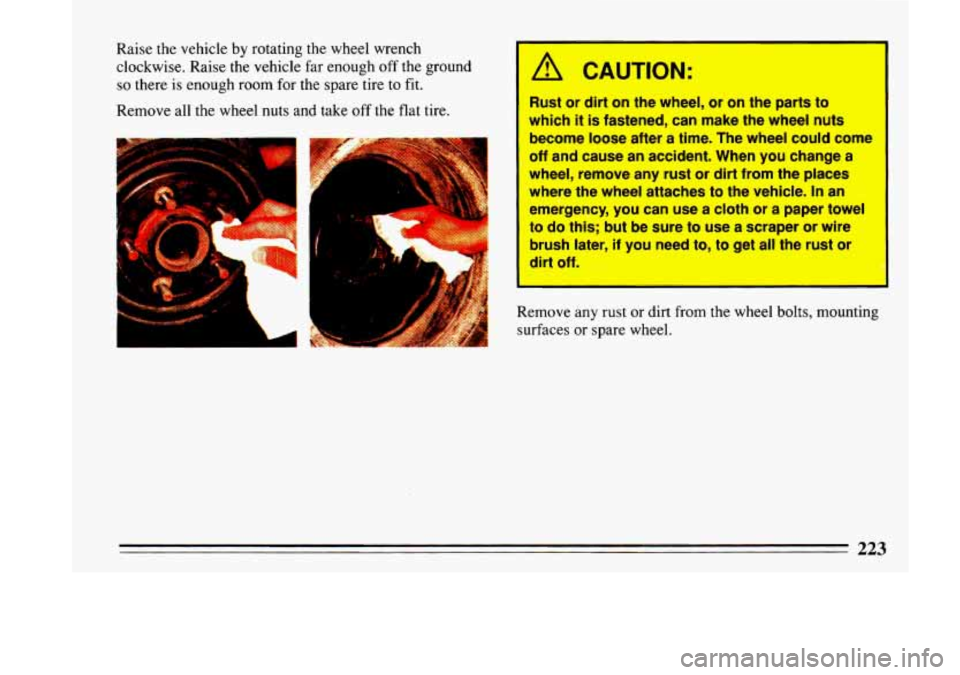
Raise the vehicle by rotating the wheel wrench
clockwise. Raise
the vehicle far enough off the ground
so there is enough room for the spare tire to fit.
Remove all the wheel nuts and take off the flat tire.
pll
f
CAUTION:
Rust or dirt on the wheel, or on the parts to
which it is fastened, can make the wheel nuts
become loose after a time. The wheel could come
riff and cause an accident. When you change a
eel, remove any rust or dirt from the places
where the wheel attaches to the vehicle. In
an
erngrgeocy, you can use a cloth or a paper towel
to do this; but be sure to use a scraper or wire
dirt Offa "
brush later, if you need to, to get all the rust or
I
Remove any rust or dirt from the wheel bolts, mounting
surfaces or spare wheel.
223
Page 226 of 324
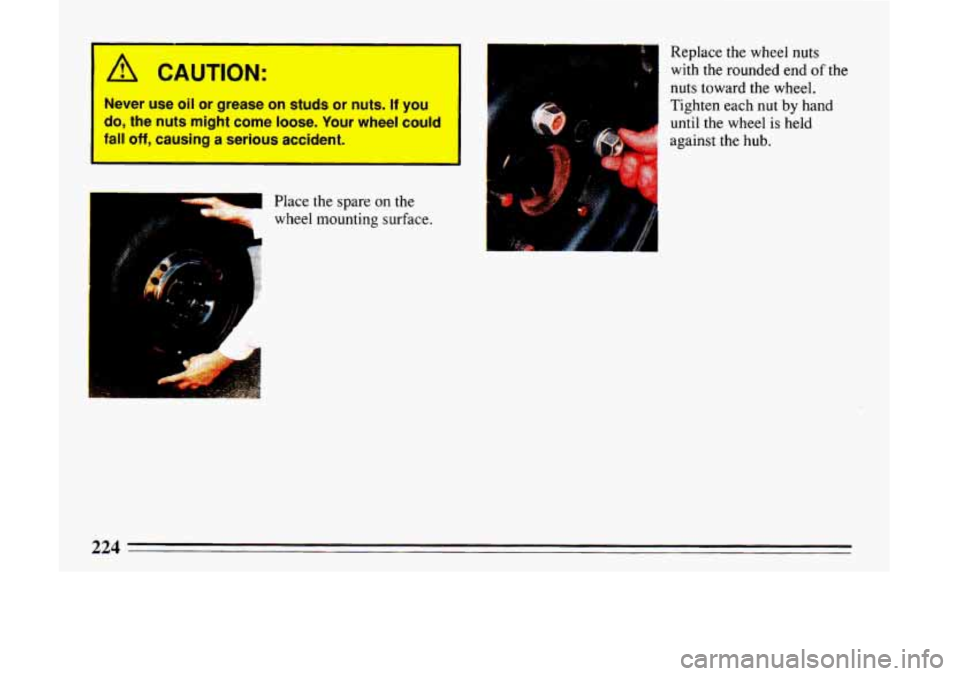
* A
wheel mounting surface.
..
, . ..
A?%%
-
I A CAUTION:
Replace the wheel nuts
with the rounded end of the
nuts toward the wheel.
Never use oil or grease on studs or nuts. If you Tighten each nut by hand
do; the nuts might come loose. Your wheel could until the wheel is held
fall off, causing a serious accident. against the hub.
Place the spare on the -- -
P
Page 228 of 324
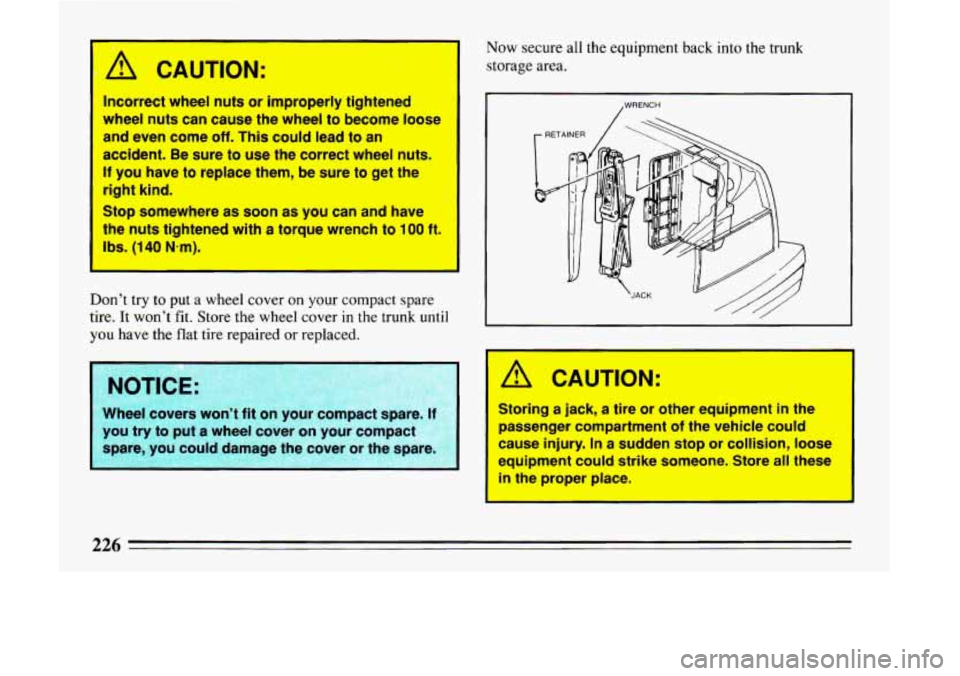
/I CAUTION:
Incorrect wheel nuts or improperly tlghtened
wheel nuts
can cause-the wheel to become loose
and even’come
off. This could lead to an
acclelent. Be sure to use the correct wheel nuts.
If you have to replace them, be sure to get the
right kind.
Stop somewhere
as soon as you can and have
the nuts tightened with a torque wrench to 100 ft.
Ibs. (1 40 Nmm).
Don’t try to put a wheel cover on your compact spare
tire. It won’t fit. Store the wheel cover in
the trunk until
you have the flat tire repaired or replaced.
Wheel covers won’t fit on your compact spare. If
you try to put a wheel cover on your compact
spare, you could damage the cover or the spare.
Now secure all the equipment back into the trunk
storage area.
I /WRENCH
&!b, CAUTION:
I
Storing a jack, a tire or other equipment in the
passenger compartment of the vehicle could
cause injury. In a sudden stop
or collision, loose
equipment could strike someone. Store
all these
in the proper place.
226
Page 229 of 324
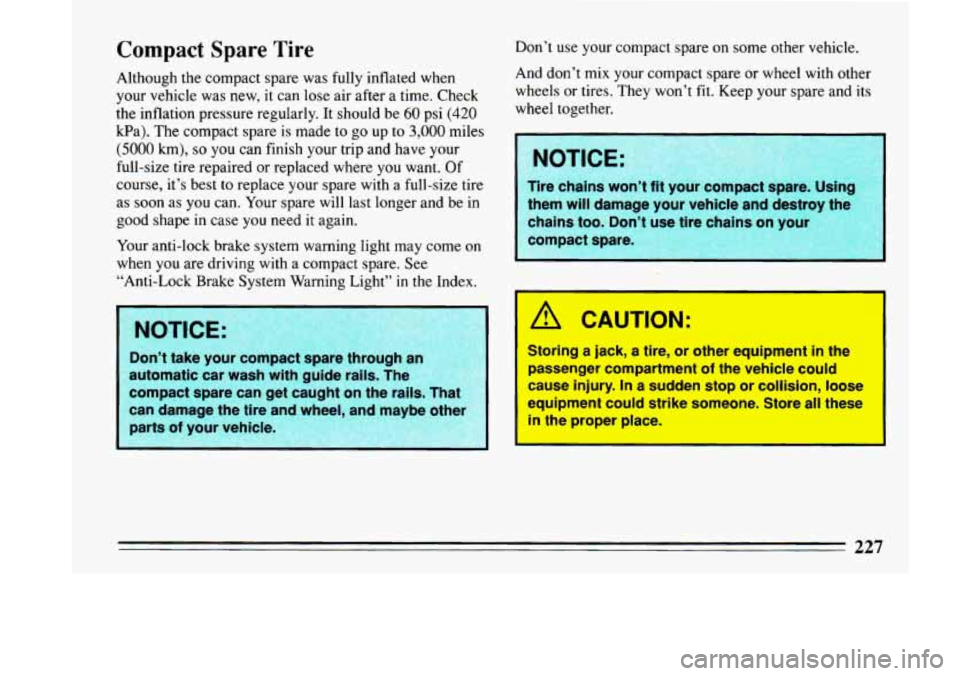
Compact Spare Tire
Although the compact spare was fully inflated when
your vehicle was new, it can lose air after a time. Check
the inflation pressure regularly. It should be
60 psi (420
Wa). The compact spare is made to go up to 3,000 miles
(5000 km), so you can finish your trip and have your
full-size tire repaired or replaced where you want. Of
course, it’s best
to replace your spare with a full-size tire
as soon as
you can. Your spare will last longer and be in
good shape in case you need it again.
Your anti-lock brake system warning light may come
on
when you are driving with a compact spare. See
“Anti-Lock Brake System Warning Light” in the Index. Don’t
use your
compact spare on some other vehicle.
And don’t mix your compact spare or wheel with other
wheels or tires. They won’t fit. Keep your spare and its
wheel together.
Tire chains wo
them will damage
y
chains too. Do
compact spar I
A CnUTION:
Storing a jack, a tire, or other equipment in the
passenger compartment of the vehicle could
cause injury. In a sudden stop or colllsian, loose
mwipment could strike someone. Store all these
.__ the proper place.
I
227
Page 261 of 324
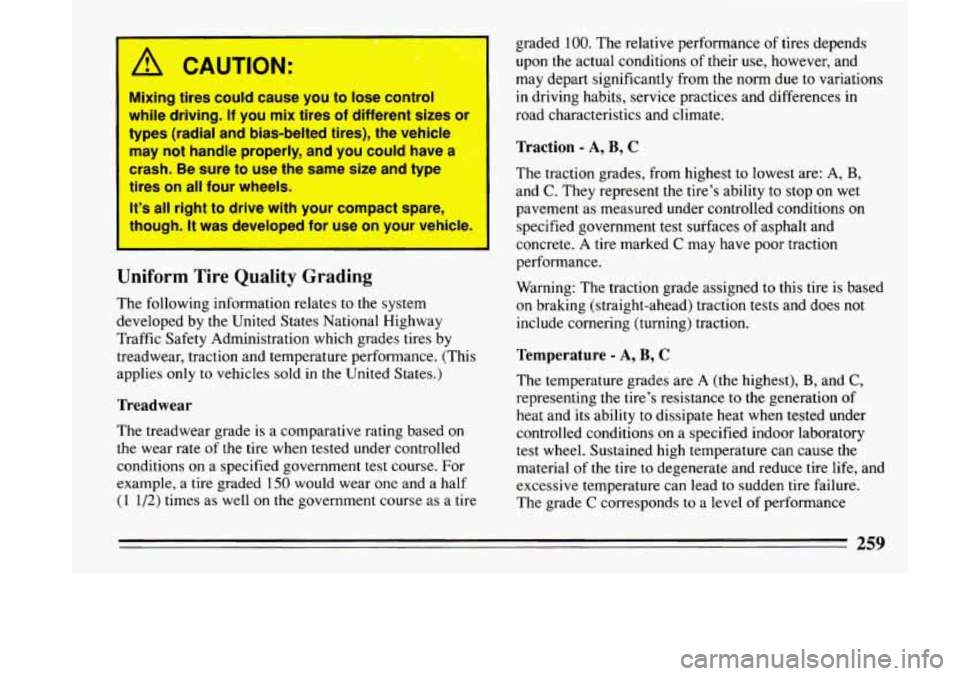
A CAUTION:
;
Mixing tires could cause you to lose control
while driving. If you mix tires of different sizes
or
types (radial and bias-belted tires), the vehicle
may not handle properly, and you could have a
crash. Be sure to use the same size and type
tires
on all four wheels.
It’s all right to drive with your compact spare,
though. It was developed for use on your vehicle.
I I
Uniform Tire Quality Grading
The following information relates to the system
developed by the United States National Highway
Traffic Safety Administration which grades tires by
treadwear, traction and temperature performance. (This
applies only to vehicles sold in the United States.)
Treadwear
The treadwear grade is a comparative rating based on
the wear rate of the tire when tested under controlled
conditions on a specified government test course. For
example,
a tire graded 150 would wear one and a half
(1 1/2) times as well on the government course as a tire graded
100. The relative performance
of tires depends
upon the actual conditions
of their use, however, and
may depart significantly from the norm due to variations
in driving habits, service practices and differences in
road characteristics and climate.
Traction - A, B, C
The traction grades, from highest to lowest are: A, B,
and C. They represent the tire’s ability to stop on wet
pavement as measured under controlled conditions
on
specified government test surfaces of asphalt and
concrete.
A tire marked C may have poor traction
performance.
Warning: The traction grade assigned to this tire
is based
on braking (straight-ahead) traction tests and does not
include cornering (turning) traction.
Temperature - A, B, C
The temperature grades are A (the highest), B, and C,
representing the tire’s resistance to the generation of
heat and its ability to dissipate heat when tested under
controlled conditions on a specified indoor laboratory
test wheel. Sustained high temperature can cause the
material
of the tire to degenerate and reduce tire life, and
excessive temperature can lead to sudden tire failure.
The grade
C corresponds to a level of performance
Page 309 of 324

Weather Strips ................................ 266
White Sidewall Tires
........................... 266
Windshield and Wiper Blades
.................... 265
Comfort Control System
.......................... 11 8
Clock. Setting the
..................... 130.132.134. 137
Closed-In Places. Don't Idle in
...................... 81
COinYourExhaust
............................... 81
Color of Road Signs
.............................. 146
Comfort Control
& Audio Systems .................. 11 8
Compact Disc Care .............................. 142
Compact Spare Tire
.............................. 227
Contents. Table of
................................. 9
Control of
a Vehicle .............................. 158
Control.
Loss of ................................. 168
Controls. Features and
....... .- .................... 57
Convex Outside Mirror
.......................... ;" 100
Convenience Net ................................. 101
Coolant. Engine ................................. 243
Coolant. Engine. Warning Light
.................... 110
Coolant. Safety Warnings About
.................... 208
Covers.
How to Remove Wheel ...................... 21 8
Cruise Control ................................... 89
Cruise Control. Changing Speed With
................. 92
Cruise Control. Turning
Off ......................... 94
Cruise Control. Using on Hills
....................... 94
Curves. Driving
on ............................... 163
Customer Assistance Information
................... 297
Customer Satisfaction Procedure
.................... 297
Courtesy Lights
.................................. 97
.............................
8
(Drive) Third Gear 75
Automatic Overdrive
........................... 74
Damage to Finish
................................ 267 Damage to Sheet Metal
.......................... .26
7.
Damagewarnings
................................ 11
Daytime Running Lights ........................... 98
Dead Battery. What to Do
......................... 198
Defensive Driving
............................... 154
Defogger.
Rear Window ...................... 124. 127
Defogging
................................. 123. 126
Defrost
.................................... 124. 126
Delco Sound Systems
............................ 127
Dimensions
.................................... 273
Disc Brake Wear Indicators
......................... 162
Disposal. Used Oil
............................... 240
Door Locks
...................................... 59
Downhill Parking
................................ 182
Downshifting
.................................... 75
Driving
AtNight
.................................... 169
Defensively
.................................. 154
Drunk
...................................... 155
In a Foreign Country
........................... 232
In Cities
..................................... 175
In Fog. Mist or Haze ........................... 173
InRain
..................................... 171
In Winter
.................................... 185
On a Long Trip
............................... 178
On Freeways
................................. 176
On Curves
................................... 163
On Hill and Mountain Roads
.................... 180
On Snow or Ice
............................... 186
Through Deep Standing Water
.................... 71
DrunkenDriving
................................ 155
Dual Automatic ComforTemp Climate Control
......... 119
307
.